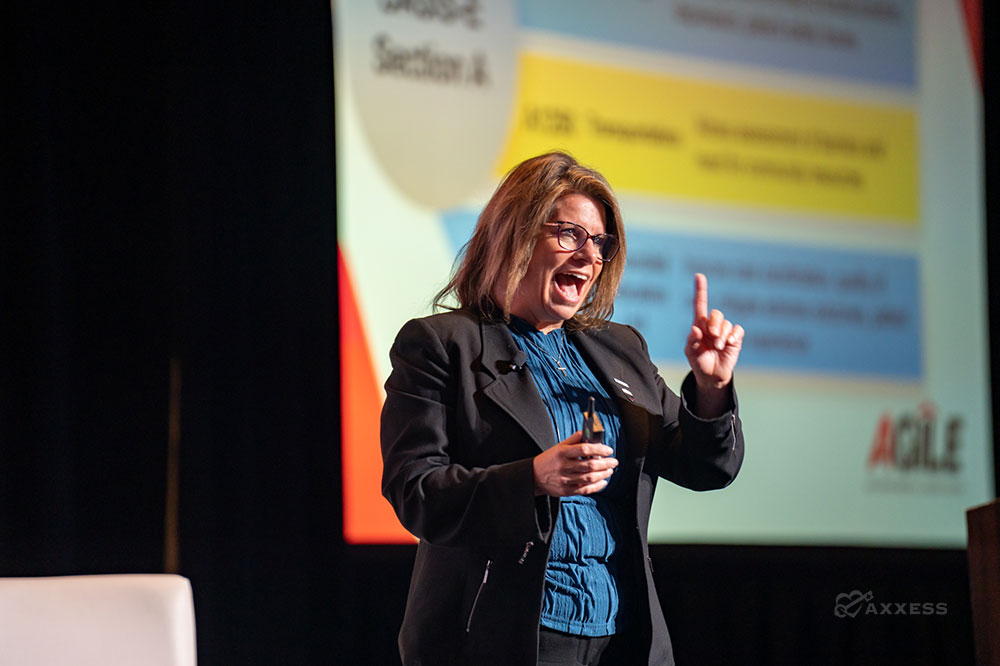
The Quadruple Aim has emerged as a guiding principle for transforming and enhancing patient care. Industry experts argue it’s crucial to apply this framework to address the unique challenges in care at home, such as declining reimbursement for home health, increased productivity expectations and ongoing staffing shortages.
During an education session at the 2023 Axxess Growth, Innovation and Leadership Experience (AGILE), Wendy Conlon, MSPT, a physical therapist and Senior Vice President of Client Experience at Axxess, explained the Quadruple Aim and how it can transform the comprehensive assessment in home healthcare.
“We want to empower change,” Conlon said. “We want to empower people to be able to make change. That’s how we’re going to change the future of care in the home.”
Understanding the Quadruple Aim
The Quadruple Aim is a framework introduced in 2014 and expands on the Triple Aim with the addition of the well-being of healthcare providers. Supporters of the new framework argued that provider well-being had significant impact on the success of the other three areas. The Quadruple Aim is made up of:
- Improving Population Health: Preventing and managing prevalent, costly chronic diseases.
- Reducing Cost of Care: Reducing resource utilization and readmissions while assuming greater risk.
- Enhancing the Patient Experience: Motivating and engaging patients to play an active role in their care to improve quality outcomes and safety.
- Improving Provider Satisfaction: Providing access to tools and resources to address provider burden and burnout.
“We need to serve our clinicians so they can serve our patients,” Conlon said. “We’ve got to be putting resources in place to help make our clinicians strong.”
The Comprehensive Assessment
The comprehensive assessment is a key area where home health organizations can integrate the Quadruple Aim in their practices. Conlon emphasized that with today’s technology, much of the work can either be automated or the burden significantly reduced, ultimately leading to better care for the patient.
Data for the assessment is gathered through interview, observation and the in-person physical assessment at the patient’s home. The new Outcome and Assessment Information Set (OASIS-E) includes a more standardized approach to the care and quality measures, including gathering information on the social determinants of health for the patient. One approach Conlon suggested to help streamline the assessment for the clinician is to incorporate a separate screening call using non-clinical staff.
“If we have a script and we have an ‘If/Then’ statement where if the patient answers ‘yes,’ ask this question and if the patient answers ‘no,’ ask this question, [that information can be] fed right into the [electronic medical record],” Conlon said. “That’s information that can already go on the comprehensive assessment for the clinician to validate in the home.”
Non-clinical staff can be especially helpful in gathering information that can inform social determinants of health, such as the patient’s home environment and caregiver support. “If we know the social determinants of health, we’ve given those clinicians some resources to help them on day one,” Conlon said.
Aiming for Success
Bringing clinical teams and intake staff together could help create an atmosphere of collaboration that not only achieves all the goals of the Quadruple Aim but also efficiently and effectively completes the comprehensive assessment. Conlon used the reconciled medication list section of the OASIS-E as an example.
“We still have to go through every medication,” Conlon said. “But if things are written for us and we know that we can, at intake, do research and reach out to the referral source or reach out to the physician and verify those medications before the clinician goes in…think about the burden that that relieves for the clinician.”
With more than 250 attendees, more than 40 sponsors and countless connections made, AGILE 2023 was a massive success for everyone. Check out the recap video and mark your calendar for AGILE 2024, April 21-24 in Dallas.
